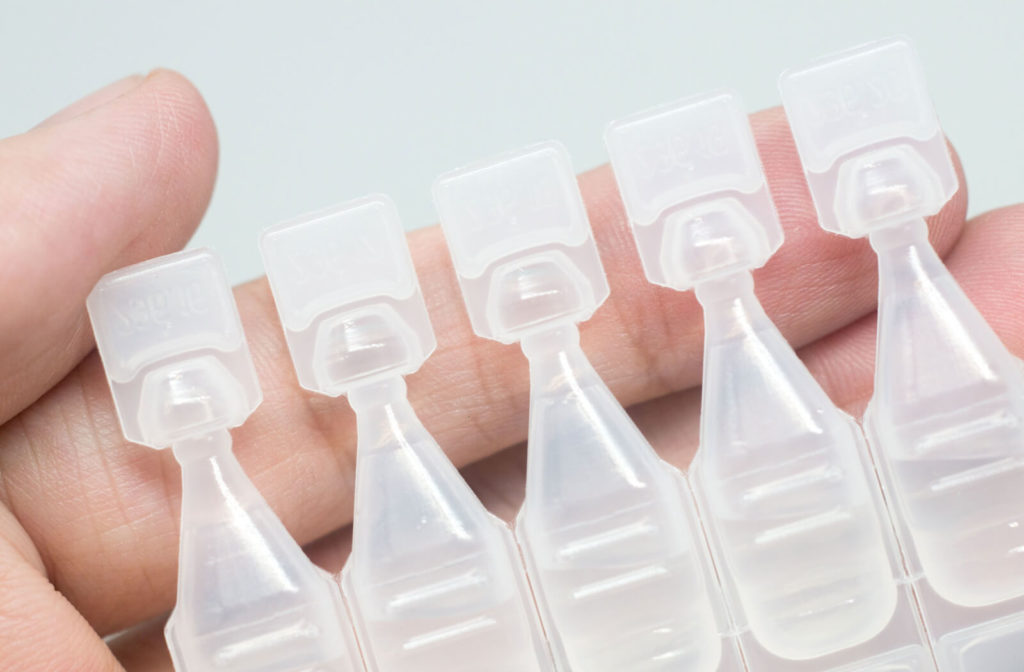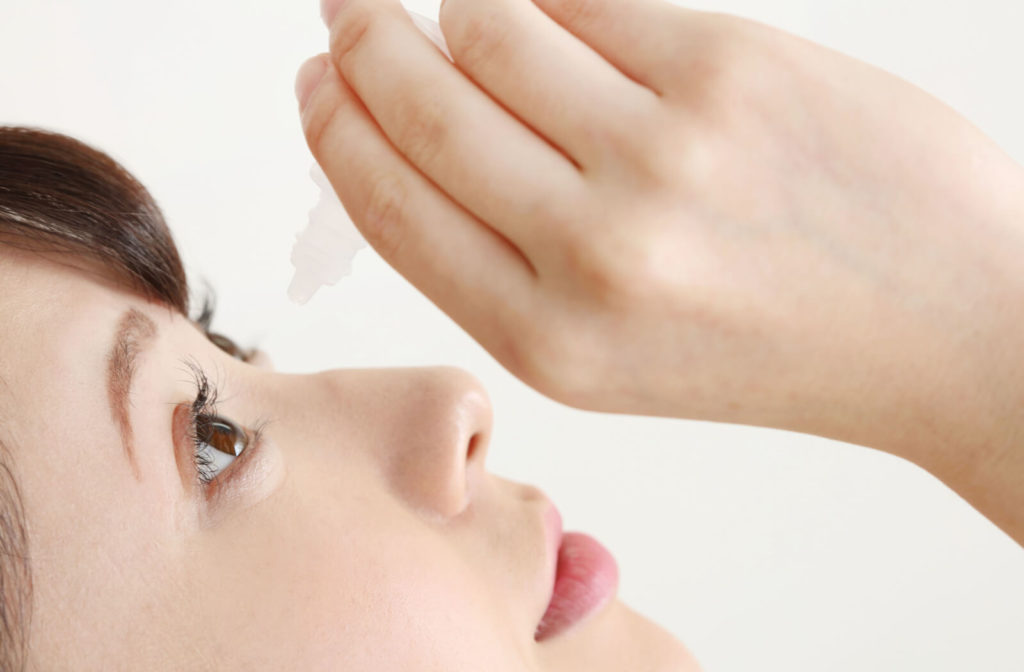Eye drops can be a great treatment option for dry eyes, allergies, or bacterial infections. They come in different types, both prescription and over-the-counter, that can be used to relieve several eye conditions. However, it’s important to know that eye drops are not typically supposed to be used when wearing contact lenses, but some eye drops can be used with contacts.
We recommend scheduling an eye exam with your optometrist to ask them if your eye drops are safe to be used when wearing contact lenses. Getting relief from eye conditions can be easier and safer when you have guidance from an eye care professional.
Eye Drops You Can Use with Contacts
Some eye drops are safe to use with contact lenses and can help to relieve discomfort you might be experiencing from dry eyes or allergies. The types of eye drops that can be used with contacts include:
Rewetting Eye Drops
Rewetting eye drops are designed to keep your eyes well-lubricated, hydrated, and moist when wearing contact lenses. Typically, these eye drops will be labeled with the phrase, “for contacts” to let you know they are safe for use.
Preservative-Free Eye Drops
Many preservative-free eye drops can be used with contact lenses. They are generally made without chemicals that could soak into the lens of your contacts and cause discomfort or redness.
Eye Drops Not to Use with Contacts
Most eye drops are not intended to be used when you are wearing contact lenses. It’s recommended to check with your optometrists if you’re unsure your eye drops are safe to use with contacts.
Medicated Eye Drops
Medicated eye drops are generally used to treat an eye condition or infection and should not be used when wearing contact lenses. In fact, the vast majority of prescription eye drops will likely require that you use them without your contacts in. Check with your optometrists if you have further questions.
Vasoconstrictor Eye Drops
Vasoconstrictor eye drops like Naphazoline are generally used to reduce redness in your eyes by targeting swollen blood vessels. It is recommended that you do not wear contacts when using these eye drops.

How Do You Use Eye Drops with Contact Lenses?
If you are wearing contact lenses but need eye drops, speak with your optometrist first to confirm that they are safe to use with contacts.
Here are some tips on putting in eye drops:
- Wash your hands with soap and water before bringing them close to your eyes
- Gently shake the eye drop bottle if recommended to do so by your doctor or the instructions on the bottle
- Store the bottle as described in the instructions
- Don’t let the bottle’s opening touch your eyes or fingers
- Don’t share your eye drops with other people
If you have further questions on how to use eye drops, book an appointment with Dr. Taylor Bladh and his team to learn more.
Are There Different Types of Contact Lenses?
Contact lenses can correct a wide range of vision issues like myopia, hyperopia, or astigmatism. Contacts commonly come as hard or soft lenses, but there are also other specialized types of contacts for other vision and eye health needs.
Hard Contact Lenses
Hard contact lenses are typically a combination of plastic and other sturdier materials that help them to hold their shape. This contact lens can sometimes be beneficial for people with soft contact discomfort or an unevenly curved cornea.
Soft Contact Lenses
Soft contact lenses are more flexible, and many people opt to wear them daily. Some soft contact lenses you can get include extended-wear, daily wear, or colored contacts.
Tips for Taking Care of Your Contact Lenses
Contact lenses should be carefully cleaned and taken care of to promote good ocular health. Here are a few tips for properly taking care of contacts:
- Follow your doctor’s instructions about wearing and replacing your contacts
- Avoid sleeping while wearing contact lenses
- Avoid showering, swimming, or getting your contacts very wet
- Wash and dry your hands carefully before touching your contact lenses
- Keep your contact lens case clean
- Use saline solutions carefully when cleaning your lenses
- Book regular eye exams
Signs You Should Remove Your Contact Lenses
Some contact lenses, typically extended-wear contacts, can be worn for longer periods. Still, they should be removed when necessary and carefully stored away.
Here are a few signs that it might be time to remove your contact lenses:
- Your eyes are red
- You are experiencing discomfort in your eyes
- Blurry vision
If you are experiencing any of these symptoms, book an appointment for an eye exam to check for any other vision-related problems that could be causing them.
Book an Appointment Today
If you are experiencing any difficulties with your contact lenses or vision, book an appointment with Dr. Taylor Bladh and his team to have a comprehensive eye exam. We will be happy to discuss your ocular health and the services we can offer to help you maintain comfortable, clear vision.



